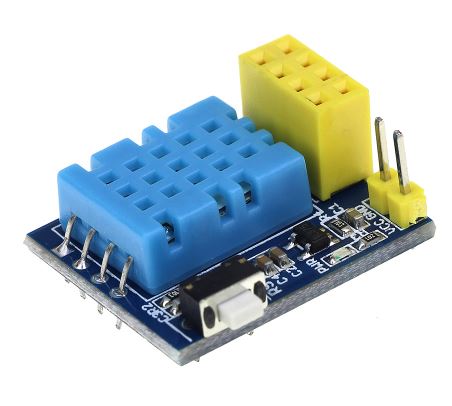#include "ESP8266WiFi.h"
#include "WiFiClient.h"
#include "ESP8266WebServer.h"
#include "DHT.h"
#define DHTTYPE DHT11 //could be DHT22
#define DHTPIN 2
const char* ssid = "test";
const char* password = "test";
ESP8266WebServer server(80);
// Initialize DHT sensor
// NOTE: For working with a faster than ATmega328p 16 MHz Arduino chip, like an ESP8266,
// you need to increase the threshold for cycle counts considered a 1 or 0.
// You can do this by passing a 3rd parameter for this threshold. It's a bit
// of fiddling to find the right value, but in general the faster the CPU the
// higher the value. The default for a 16mhz AVR is a value of 6. For an
// Arduino Due that runs at 84mhz a value of 30 works.
// This is for the ESP8266 processor on ESP-01
DHT dht(DHTPIN, DHTTYPE, 11); // 11 works fine for ESP8266
float humidity, temp_f, temp_c; // Values read from sensor
String webString = ""; // String to display
// Generally, you should use "unsigned long" for variables that hold time
unsigned long previousMillis = 0; // will store last temp was read
const long interval = 5000; // interval at which to read sensor minimum 2000
String page = "";
void handle_root() {
server.send(200, "text/html", "Hello Karl from the weather esp8266, read from /temp or /humidity
Temp
Humid
");
delay(100);
}
void setup(void)
{
// You can open the Arduino IDE Serial Monitor window to see what the code is doing
Serial.begin(115200); // Serial connection from ESP-01 via 3.3v console cable
dht.begin(); // initialize temperature sensor
// Connect to WiFi network
WiFi.begin(ssid, password);
Serial.print("\n\r \n\rWorking to connect");
// Wait for connection
while (WiFi.status() != WL_CONNECTED) {
delay(500);
Serial.print(".");
}
Serial.println("");
Serial.println("DHT Weather Reading Server");
Serial.print("Connected to ");
Serial.println(ssid);
Serial.print("IP address: ");
Serial.println(WiFi.localIP());
server.on("/", handle_root);
server.on("/temp", []() { // if you add this subdirectory to your webserver call, you get text below :)
gettemperature(); // read sensor
// temp_f = (temp_f - 32) * 5 / 9;
webString = "Temperature: " + String((int)temp_f)+ " °C"; // Arduino has a hard time with float to string
server.send(200, "text/html", webString + "
Retour
"); // send to someones browser when asked
});
server.on("/humidity", []() { // if you add this subdirectory to your webserver call, you get text below :)
gettemperature(); // read sensor
webString = "Humidity: " + String((int)humidity) + " %";
server.send(200, "text/html", webString + "
Retour
"); // send to someones browser when asked
});
server.begin();
Serial.println("HTTP server started");
}
void loop(void)
{
server.handleClient();
}
void gettemperature() {
// Wait at least 2 seconds seconds between measurements.
// if the difference between the current time and last time you read
// the sensor is bigger than the interval you set, read the sensor
// Works better than delay for things happening elsewhere also
unsigned long currentMillis = millis();
if (currentMillis - previousMillis >= interval) {
// save the last time you read the sensor
previousMillis = currentMillis;
// Reading temperature for humidity takes about 250 milliseconds!
// Sensor readings may also be up to 2 seconds 'old' (it's a very slow sensor)
humidity = dht.readHumidity(); // Read humidity (percent)
temp_f = dht.readTemperature(); // Read temperature as Celsius
//temp_f = dht.readTemperature(true); // Read temperature as Fahrenheit
// Check if any reads failed and exit early (to try again).
if (isnan(humidity) || isnan(temp_f)) {
Serial.println("Failed to read from DHT sensor!");
return;
}
}
}



